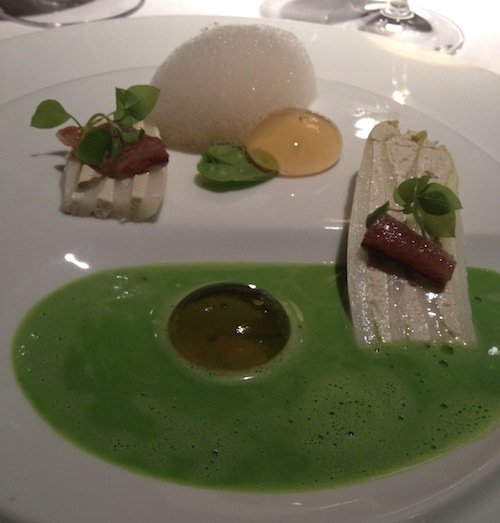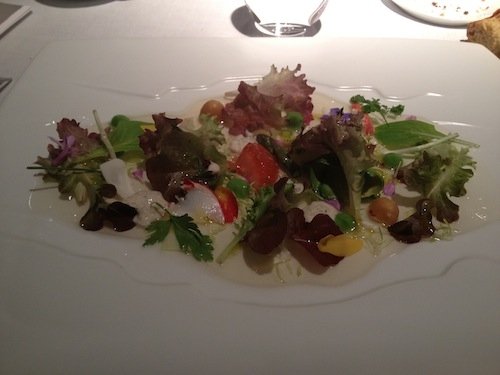[continued] We arrive at Martin Berasategui and I almost burst into tears. I had never crossed the main door of this temple of cuisine. I still remember when I went from my bed to the restaurant, under the rain, in the cold, wearing a pair of Birkenstock and dressed as a chef, at 8.30 in the morning, after a few hours sleep, together with my 8 roommates, all living in a 40 sq. metre flat. I was finally going back to the restaurant where I learnt the meaning of “restaurant”. Perfection was everywhere. People were bursting into tears during the service, those who gave up. The pil pil. A 200 sq. metre kitchen. Monday. Calamari arriving while they’re still alive.

Ballon affumicato con mille foglie di indivia, pesce all'olio, centocchio, crescione
greets us. He’s a real maître, a person with passion for his work. At the time, when I saw him making a knot on the tie of his interns I got the chills. Then come our two waiters with white gloves; the nice and not intrusive sommelier; the tour of the kitchen as soon as we arrive, the good
Martin recognizes me. Tears everywhere. We have a menu custom-designed for us: the “degu” is not enough for us chefs. We decide to taste almost all the dishes and thank God they prepare them for us. We start with the
Apple, foie and smoked eel terrine that I had prepared so many times,
scallion sauce…
We continue with the Squid raviolo in squid stock, one of the most complicated dishes I have ever cooked, and one of the most delicious I have ever tasted. I’d like to stress that for every portion 3 ravioli are put in the oven, to be on the safe side, and each raviolo requires really a lot of work. But this is something those who criticise expensive restaurants don’t understand. The tibia salad: I remember when I ate it in secret, inside the main courses’ refrigerating room. I must say that having it at the table makes quite a difference. The salads grown on site, the tomato gelatine I used to prepare burning my arms in the tomato acid when I was in punishment at Monday’s. Memories. Tears.

L'insalata tibia di Martin Berasategui
. This, for me, is
Martin. I remember that, when he arrived in the kitchen, he pushed all of us interns as if he were a god. He took the pan to make
kokotxas, the most important dish for the Basques. One of the most simple, for me. No gelatines, no molecular cuisine. No frills, only first quality ingredients. There’s a kokotxas for every cod. We had 6 altogether. It’s the part below the lower jaw, the muscle that controls it. The
Tripe stew. Another dish that makes
Martin differ from other 3 starred chefs. I remember when I was still at
Alinea in Chicago and at some point I craved for tripe stew… In the evening we go back to the mythical
Dicken's para hacer one (only one?) gin tonic con
pepino y pimienta… The following day we had managed to get a table at
Akelarre but tired, bursting and still drunk we decided to cancel and safeguard the health of our liver.
Thing is, guys: life is short, money serves also to pursue, satisfy and nurture your passions. So, if you can, take a plane, travel, visit the 3 starred restaurant and the 5 starred hotels, drink shampu as if there were no tomorrow. One day you might discover you have no time left to do so. Go on culinary weekends during which you can eat stratospheric quantities of quality food, and... now we’re ready to go to Japan. We were thinking of trying 22 stars in 10 days. And as for the shampu, let’s not even talk about it.
2. the end